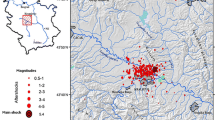Abstract
Following the Pohang and Gyeongju earthquakes and their aftershocks, there is no longer any zone that is safe from earthquake-related disasters in the Korean Peninsula. In order to monitor and predict earthquakes, correlation analysis of earthquakes and hydro-environmental factors are insufficient, and the development and application of hydro-environmental factor measurement equipment is still in the early stages. This study developes and verifies a more precise radon measurement device. Four specific earthquake cases (2019–2020) were selected, and the correlation of the analyses of the earthquakes and hydro-environmental factors (radon, electric conductivity (EC), water-level (WL), and water-temperature (WT)) was conducted at the three specific groundwater stations. Accordingly, was confirmed that four factors are affected by earthquakes or seismic movement. Furthermore, the variability of the EC showed an identical tendency for a certain period before an earthquake occurred, and, in particular, the variability trends for radon, WL, and EC coincided at the time of the earthquake’s occurrence.
Similar content being viewed by others
References
Abdullabekov KN and Yusupov VR (2022), “Models (Form) of Long-, Medium- and Shor-Term Earthquake Precursors,” Geodesy and Geodynamics, 13(6): 609–618.
Cartigny P, Jendrzejewski N, Pineau F, Petit E and Javoy M (1995), “Volatile (C, N, Ar) Variability in MORB and the Respective Roles of Mantle Source Heterogeneity and Degassing: the Case of the Southwest Indian Ridge,” Earth and Planetary Science Letters, 194(1–2): 241–257.
Chadha RK, Kuempel HJ and Shekar M (2008), “Reservoir Triggered Seismicity and Well Water Level Response in the Koyna-Warna Region, India,” Tectonophysics, 456(1–2): 94–102.
Chen Y, Wen L and Ji C (2014), “A Cascading Failure During the 24 May 2013 Great Okhotsk Deep Earthquake,” Journal of Geophysical Research: Solid Earth, 119(4): 3035–3049.
Chia Y, Wang YS, Chiu JJ and Liu CW (2001), “Changes of Groundwater Level Due to the 1999 ChiChi Earthquake in the Choshui River Alluvial Fan in Taiwan,” Bulletin of the Seismological Society of America, 91(5): 1062–1068.
Goto M, Yasuoka Y, Nagahama H, Moto J, Omori Y, Ihara H and Mukai T (2017), “Anomalous Changes in Atmospheric Radon Concentration Before and After the 2011 Northern Wakayama Earthquake (MJ 5.5),” Radiation Protection Dosimetry, 174(3): 412–418.
Jeong CH, Kim MS, Lee YJ, Han JS, Jang HG and Jo BU (2011), “Hydrochemistry and Occurrence of Natural Radioactive Materials Within Borehole Groundwater in the Cheongwon Area,” Engineering Geology, 21(2): 163–178. (in Korean)
Kim E, Kim B and Yoon DK (2021), “Estimation of the Spatial Impact of the Pohang Earthquake on Regional Economies: Development of the SCGE Model,” Journal of Korean Society Hazard Mitigation, 21(1): 269–279. (in Korean)
Kim GB, Choi MR, Lee CJ, Shin SH and Kim HJ (2018), “Characteristics of Spatio-Temporal Distribution of Groundwater Level’s Change After 2016 Gyeongju Earthquake,” Journal of the Geological Society of Korea, 54(1): 93–105. (in Korean)
Kim YS, Lee CM, Lee SI, Iida T and Yoshioka K (2003), “A Study of the Prediction of Earthquake Occurrence by Detecting Radon Radioactivity,” Journal of Environmental Sciences, 12(6): 677–688. (in Korean)
Kitagawa G and Matsumoto N (1996), “Detection of Coseismic Changes of Underground Water Level,” Journal of the American Statistical Association, 91(434): 521–528.
Kitagawa Y, Koizumi N, Takahashi M, Matsumoto N and Sato T (2006), “Changes in Groundwater Levels or Pressures Associated with the 2004 Earthquake off the West Coast of Northern Sumatra (M9.0),” Earth, Planets and Space, 58(2): 173–179.
Korea Meteorological Administration (2010), Monitoring Radon as a Portent of Earthquakes, CATER 2010–5304, Seoul, Seoul National University: 19–28. (in Korean)
Lee JY (2016), “Gyeongju Earthquakes Recorded in Daily Groundwater Data at National Groundwater Monitoring Stations in Gyeongju,” Journal Soil and Groundwater Environment, 21(6): 80–86. (in Korean)
Miklavčič I, Radolič V, Vukovič B, Poje M, Varga M, Stanič D and Planinič J (2008), “Radon Anomaly in Soil Gas as an Earthquake Precursor,” Applied Radiation and Isotopes, 66(10): 1459–1466.
Raushan R and Ajay K (2021), “Forecasting Ground Movement of Patna Region, India,” Earthquakes and Structures, 20(2): 487–494.
Rikitake T (1979), “Classification of Earthquake Precursors,” Tectonophysics, 54(3–4): 293–309.
Tiwari RK, Lakshmi SS and Rao KNN (2004), “Characterization of Earthquake Dynamics in Northeastern India Regions: A Modern Nonlinear Forecasting Approach,” Pure and Applied Geophysics, 161: 865–880.
Tsunomori F and Tanaka H (2014), “Anomalous Change of Groundwater Radon Concentration Monitored at Nakaizu Well in 2011,” Radiation Measurement, 60: 35–41.
Woo JU, Kim M, Rhie J and Kang TS (2020), “Aftershock Analysis of the 2017 MW 5.5 Pohang Earthquake, South Korea,” 2020 Proceeding of The Geological Society of Korea, Online Conference, Oct. 27–29, 57.
Woo NC, Piao J, Lee JM, Lee CJ, Kang IO and Choi DH (2015), “Abnormal Changes in Groundwater Monitoring Data Due to Small-Magnitude Earthquakes,” Engineering Geology, 25(1): 21–33. (in Korean)
Xiong ZM, Zhang C, Hao XP, Chen X and Ochoa JJ (2020), “Distributing Disciplinarian of Ground Motion Parameters on an Earth Fissure Site During Strong Earthquakes,” Earthquake Engineering and Engineering Vibration, 19(3): 597–610.
Yan R, Woith H and Wang R (2014), “Groundwater Level Changes Induced by the 2011 Tohoku Earthquake in Chinese Mainland,” Geophysical Journal of International, 199(1): 533–548.
Acknowledgment
The Institute of Engineering Research at Daejin University provided research facilities for this work.
Author information
Authors and Affiliations
Corresponding author
Additional information
Supported by: National Research Foundation of Korea (NRF) Grant by the Korea Government (MSIT) under Grant No. NRF-2021R1A2C1004790
Rights and permissions
About this article
Cite this article
Lee, JK. A comprehensive approach to a variability analysis between earthquake activity and hydro-environmental factors on the Korean Peninsula. Earthq. Eng. Eng. Vib. 22, 937–950 (2023). https://doi.org/10.1007/s11803-023-2212-x
Received:
Accepted:
Published:
Issue Date:
DOI: https://doi.org/10.1007/s11803-023-2212-x




